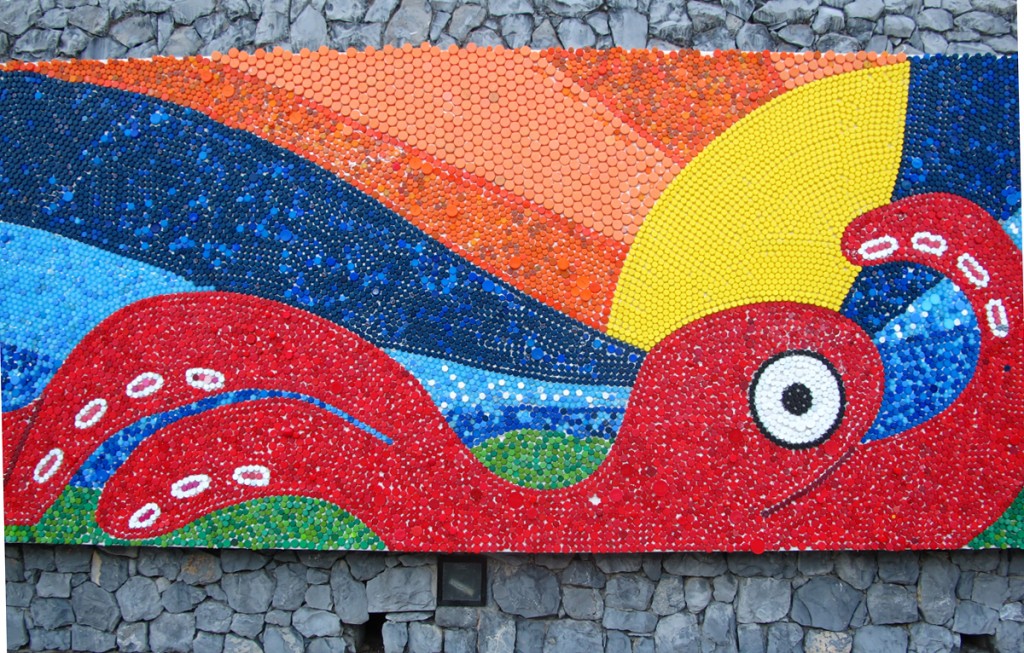Trash and the Future of Traveling Museum Exhibits
A traveling exhibit ditches the trucks and goes digital to teach environmentally-friendly ways of living

An octopus design on a mosaic at Planetario Alfa museum in Mexico. The mural, made out of 60,000 bottle caps, is part of “Green Revolution,” a traveling exhibit that teaches creative ways to reduce waste and conserve energy. Photo courtesy of SITES.
“Green Revolution” is a traveling exhibit that practices what it preaches. Since April 2011, it has made its way around America educating visitors about eco-friendly ways of living, and it has done so without gas-guzzling trucks or plastic-filled crates.
Normally, the Smithsonian Institution Traveling Exhibition Service (SITES), the organization that designs and distributes the Institution’s on-the-go exhibits, ships full-scale exhibition packages to the exhibits’ host museums. These packages include objects, photographs, interpretive texts, displays and computer and audiovisual equipment. Since SITES launched in 1951, it has distributed more than 1,500 shows across the country and abroad.
With “Green Revolution,” however, SITES only provides the blueprints. “The host museums download files and then build it themselves, so we don’t ship anything to them,” explains Lindsey Koren, a SITES spokesperson. Because host museums must find their own materials, they are challenged to be environmentally creative with their designs, and to involve their local communities in the construction process.
At Planetario Alfa, an upcoming host museum in Nuevo Leon, Mexico, the staff recently held a bottle cap collection to build a mural for their version of the exhibit. Visitors brought in different colored caps—over 60,000—which school groups and other local volunteers then used to create a massive 8-by-79-foot mosaic (above). Its ocean theme celebrates 2013 as the United Nations-designated International Year of Water. According to a post about the mural on SITES’s blog, the project has inspired other Mexican institutions to build similar murals with their own designs.
Recycled materials make up the majority of items in “Green Revolution,” which vary from static displays to interactive stations. Divided into segments like “energy,” “recycling” and “composting,” the exhibit uses live worm compost bins, miniature wind turbines, bicycle-powered electronics and biography panels of local recycling heroes to demonstrate how small changes to our everyday lives can impact carbon footprints. Because of the exhibit’s high customizability, no version is the same. “It looks different everywhere it goes,” Koren says.
So far, the exhibit has been featured at museums in Florida, Kansas, Ohio, Missouri, Virginia, New Hampshire and, new this month, Arizona. The Mexican exhibit, which opens in March, was the first to translate all of SITES digital files into Spanish. The advantage of a digital “eco-zhibit,” Koren says, is that it can be open simultaneously at any museums that want it, with flexible opening and closing dates.
Is “Green Revolution” the future of traveling museum exhibits? “I think that it could be a model of future digital exhibits,” says Devra Wexler, SITES project director. “I would not say that it’s a model for future travel exhibits, because when you have objects to send, you’re going to send objects. But If you’re doing an exhibition that doesn’t require objects, that can be tailored and customized for a local audience, then using something digital to get everything there is a good way to go, especially if you’re trying to teach environmental responsibility.
“It’s a great way to get information to museums if they’re willing to put in a lot of effort,” she adds.
/https://tf-cmsv2-smithsonianmag-media.s3.amazonaws.com/accounts/headshot/paul-bisceglio-240.jpg)
/https://tf-cmsv2-smithsonianmag-media.s3.amazonaws.com/accounts/headshot/paul-bisceglio-240.jpg)